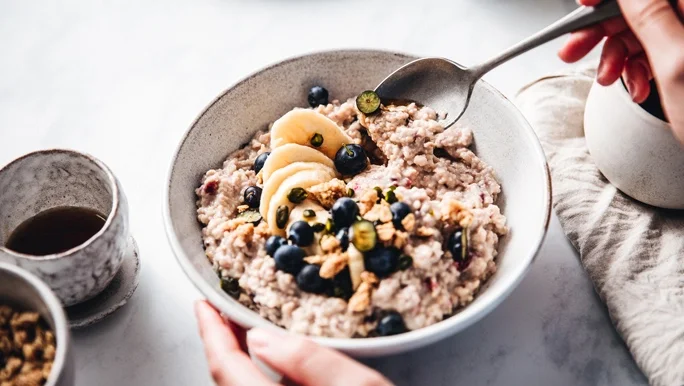When winter is upon us, porridge almost becomes a breakfast staple. Porridge really is a perfect breakfast option, and are low FODMAP. In their natural form, oats do not contain gluten. However, oats may become contaminated with gluten during processing, and therefore should be avoided by those with coeliac disease or gluten-intolerance.
Which type of oats are best?
When choosing your oats at the supermarket, the best choice is rolled oats. This is because they are low FODMAP per ½ cup serve, and have a lower GI – so break down more slowly. This provides a longer release of energy and is more gentle on our stomach.
Quick oats on the other hand are considered moderately high in FODMAPs per ½ cup serve. They are broken down much quicker, so have a higher GI value and are more likely to trigger IBS symptoms. Quick oats are low FODMAP at ¼ cup serve, so can be eaten in small amounts if time is an issue.
Rolled oats do take twice as long to cook, but in the microwave this is 4 minutes versus the 2 minutes for quick oats. So ultimately, the extra 2 minutes is worth the added benefits of rolled oats.
Why is porridge a good breakfast option?
Well firstly, oats are a good source of soluble fibre, meaning they keep us fuller for longer (and therefore help curb those mid-morning sugar cravings). Soluble fibre can also help with management of IBS symptoms, maintain healthy bowels, and help lower cholesterol. Since rolled oats are a good source of low GI carbohydrate, they provide a slower more sustained energy release to fuel our busy morning.
Oats are super cheap, low FODMAP and very versatile. But what ultimately determines how nutritious and delicious porridge is, is what you add-in. Here are a few of our low FODMAP favourites!
How to improve your porridge
For a bit more flavour:
- Ground cinnamon
- Maple syrup
- Vanilla essence
To boost the fibre content:
- Chia seeds, flax seeds and LSA (linseed, sunflower seed, almond mix).
- Fruit: raspberries, blueberries, strawberries, banana and passionfruit
- Nuts/nut butter: macadamias, <10 almonds, <10 hazelnuts, coconut (< ½ cup), peanuts/peanut butter, pecans, and walnuts.
- Dried cranberries (1 tbsp).
For some extra protein:
5 winning porridge combos
- Peanut butter and banana
- Banana and cinnamon
- Raspberry, coconut, vanilla and chia
- Maple and macadamia, walnut or pecan
- Vanilla, cranberry and macadamia
Need help with the low FODMAP diet? Our FREE dietitian developed program will guide you through it, step-by-step. Includes a low FODMAP food guide. Sign up now.
If you are experiencing gut symptoms and have not been recommended a low FODMAP diet by a health professional, get started with the manage your gut symptoms program.
Reviewed by the healthylife Advisory Board March 2022
